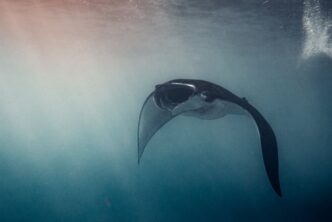Night snorkeling offers a rare chance to see the sea in a different light, literally and figuratively. Where daytime reveals shapes and motion, night reveals a living pattern of light that pulses, flickers and drifts.
Many people find the sight at once calming and thrilling, a reminder that the water holds secrets that are visible when the sun goes down.
If you’re seeking a truly unforgettable experience, consider joining a manta ray night snorkel to witness the ocean come alive beneath the stars. A careful approach makes the outing rewarding for both human visitors and the creatures they meet.
The Phenomenon Of Bioluminescence
Bioluminescence is the chemical spark that lets living things emit light, often used for signaling, hiding, or catching food. Tiny plankton and some fish and jelly produce light when moved or alarmed, creating a bright trail or sudden flash in otherwise dark water.
The mechanism is a simple chemical reaction in many species, yet the visual effect can feel almost magical to the eye. Scientists study these flashes to learn about behavior, population patterns and the flow of energy through ocean food webs.
Where You Can See The Glow
Coastal bays with calm water and a supply of plankton often put on the most reliable light shows for snorkelers. Warm waters can be prolific, but cool seas have pockets that pulse with microscopic life at certain seasons.
Protected inlets and lagoons are favored because waves and strong currents dilute the concentration of glowing organisms. Local guides and community groups can be a good source of current reports without needing to spend hours searching.
Night Snorkeling Gear Essentials
A snug mask with clear lenses and a lightweight snorkel are the basic tools for night water viewing, with a comfortable fit helping reduce fog and leaks. A low profile shirt and a thin neoprene vest keep core warmth without bulk that hinders gentle movement.
A headlamp with a red lens or a dim white light helps with entry and exit while keeping the water creatures calm. A small float or surface marker improves visibility to boats and gives a place to rest between sightings.
Safety And Group Practices
Staying with at least one other person makes it easier to watch each other and manage equipment in the dark, and a guide often adds local knowledge about currents and hazards. Moving slowly and keeping hands near the body reduces the risk of startling animals and limits accidental contact with sharp or sticky surfaces.
Tidal shifts and changing weather can alter conditions quickly so frequent checks of position and time are wise. Simple signals rehearsed on shore keep communication clear once feet leave the beach.
The Creatures That Glow
Plankton often create a mist of scattered stars with every kick or stroke, turning a hand wave into a curtain of light that lingers briefly before fading. Some jelly species make solid, haunting rings or sheets of color that float like lamps under the surface.
Small fish and shrimp sometimes flash when chased or when predators come near, turning a quiet patch of water into a scatter of sparks. Observing behavior at night can show odds and ends of life histories that daytime scenes hide.
How To Move And Watch

Glide slowly with long relaxed strokes and avoid splashing so the animals remain in a natural state rather than reacting to alarm. Point your light gently at the surface only when needed and keep it low to limit disturbance while still allowing you to see shapes and color.
Let the water close around you and listen for soft sounds that are easy to miss in daylight, like faint pops and the whisper of movement near the reef. A patient, steady presence often brings reward as shy animals reemerge and the pattern of light grows richer.
Photographing The Glow
Capturing the scene with a camera requires steady hands, longer exposure times and a housing that seals well against salt and small leaks. Using a low level artificial light close to the subject can add context without washing out natural flashes, and some photographers prefer to use the glow itself as the only light source.
Experimentation with shutter speed and ISO helps because each scene has a different mix of motion and brightness. Learning from a few test frames on shore reduces surprises once you are wet.
Environmental Etiquette
Keeping a respectful distance from flora and fauna helps preserve the very show that drew you out into the dark water, and touching reef life can harm fragile organisms quickly. Avoid stirring sediment or shaking rocks because the cloud you create obscures visibility and can smother tiny animals.
Do not collect specimens or take shells that still host living things, since a single removal can alter local balance. Quiet voices and gentle timing keep the night calm for both human and marine neighbors.
Scientific And Cultural Value
Local watchers and researchers often use reports from night snorkelers to track bloom cycles and shifts in coastal populations that matter for fisheries and conservation. Simple notes on where and when glows occur contribute to long term patterns and help spot unusual events that merit closer study.
Many coastal communities have stories and rituals around the sea at night, with glowing waters appearing in legends and seasonal memory. Participating in citizen science programs can link curiosity with useful data without needing specialized training.
Planning A Night Snorkel Trip
Check local rules, tides and weather forecasts before heading out and aim for low wind nights when the surface is glassy and reflections are pure. A first outing with an experienced local guide often shortens the learning curve and increases comfort with entry and exit in the dark.
Pack a small waterproof bag for keys and a towel and leave heavy items on shore so movement in the water stays light. Give yourself time to adjust to the dark on land so the transition to the water feels natural and calm.














